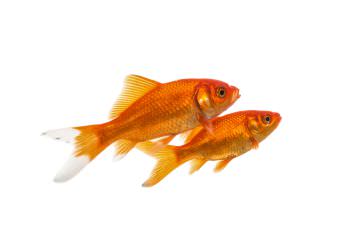Pond Fish Care Introduction
Introducing an attractive pond into your garden can really transform its appearance, creating an inviting and relaxing feature. Establishing a well-balanced environment for your fish will keep them healthy and maintain the balance of your pond. And remember to allow your fish plenty of swimming space - large fish in a small pond look less natural than a few smaller ones.
Ask for advice and always check how big your fish will grow before you buy.
Which Type Of Fish
A good mix of bottom, mid, and surface feeders will help maintain the balance of your pond. Some larger fish such as Koi have a tendency to uproot plants so are not best suited for a heavily planted pond - stick to smaller species eg: Goldfish,Shubunkins and Comets.
Goldfish
Easiest of the pond fish to keep, being a member of the carp family they can vary in colour from a red to very light gold. They will breed easily producing black young that may turn gold later in the right conditions. Goldfish can grow to 30cm but in normal British conditions they will probably reach 20cm (8in).

Shubunkins
Similar to goldfish they come in a multitude of colours including reds, greys and blues.

Koi
These most spectacular fish can reach 60cm to 90cm (2-3ft) in size and come in an array of colours and patterns. Unfortunately really only suitable for larger purpose-built ponds with a depth of at least 0.9m (3ft).

Sarasa Comets
From the same family as goldfish, but have bright red patches on a white background.

Tench
Very useful bottom feeders, clearing up any uneaten food etc. Once introduced into a pond it’s likely you will not see them often as they stay at the bottom and their olive or green/brown colour tends to blend them into the background. A golden variety is often available.

Golden Orfe
Orfe can grow up to 40cm (18in) and prefer to be kept in shoals. They are useful surface feeders, keeping the insect population in check. Blue Orfe are sometimes available. Should not be kept in smaller ponds or where there is no pump, as they require plenty of oxygen.

How Many Fish?
Stocking levels will vary depending on filtration and husbandry however a general rule for stocking is 25 cm of fish per square metre of surface area or 55cms per 1000 litres volume. To populate an empty pond, don’t rush into buying all your fish in one go. It’s far better to stock the pond gradually, giving the fish - and the pond - time to acclimatize. When stocking your pond, keep in mind your fish will continue to grow and breed.
Introducing Your Fish?
It is possible to introduce a few fish into your pond 48 hours after it has been installed and filled with the use of a suitable de-chlorinator. However we recommend waiting for about 4 weeks after the pond has been planted to give it time to settle and mature. This creates a more natural environment for your new fish.
Tips For Healthy Fish
Healthy water equals healthy fish
•est the water regularly for toxins and pH levels
Filtration and careful planting help keep toxins to a minimum
If water quality is consistently poor, the filter may need upgrading
When adding new fish to the pond, always test the water first
Remember established fish can acclimatize to a gradual decrease in water quality over time which could be fatal to new arrivals
 British Pounds
British Pounds
